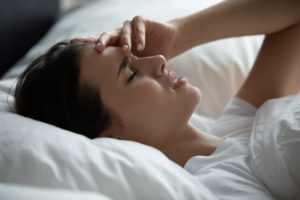What is a Fever Dream?
- Fever dreams are vivid, unpleasant dreams that sometimes accompany a fever.
- Researchers theorize that heating of the brain can affect cognitive processing, making fever dreams more strange than typical dreams.
- While fever dreams do not have a specific meaning, they often involve feelings of heat, illness, or discomfort.
- Fever dreams are not necessarily bad for your health, but many find them unsettling.
Fever dreams are one of the possible symptoms of fever. In multiple studies, sleepers describe their fever dreams as bizarre, negative, and emotionally intense . Experiences of fever dreams vary among sleepers. Some people with fevers do not recall dreaming, while others can recall their fever dreams years later.
What Is a Fever?
A fever is a sign of inflammation, and one of the body’s potential responses to infection or illness . Although there is wide variability of body temperature among individuals, a standard human body temperature is generally considered about 98.6 degrees Fahrenheit (37 degrees Celsius). Fevers are an elevated body temperature of 100.4 degrees Fahrenheit (38 degrees Celsius) or greater, taken orally in adults.
Symptoms of fever may include:
- Cold or chills
- Rigors, or severe, teeth-chattering and shaking chills
- Weakness
- Warmth
- Dampness or sweating
- Headache
- Respiratory symptoms such as cough, shortness of breath, or difficulty breathing
- Fever dreams or hallucinations
What Is a Fever Dream?
Fever dreams are vivid, often bizarre or unpleasant dreams sleepers can experience when they have a fever. These dreams happen similarly to other dreams. Although they can occur during any stage of sleep, most vivid dreams happen during rapid eye movement (REM) sleep . Waking up during or right after REM sleep can increase the chances of remembering your dream . Typically, people dream for about two hours total each night, but the dream experiences vary. Some people dream in black and white while others dream in full color.
Additionally, dreams may play a role in memory consolidation and processing emotions. In fact, one study of 299 dreams showed that half of the dreams contained at least one component tied to a specific daytime experience. As a result, fever dreams may include feelings of heat and illness.
What Causes Fever Dreams?
The exact cause of fever dreams is unknown. Some researchers speculate that the “overheated” brain affects cognitive processing and therefore makes the fever dreams more strange than typical dreams. Fevers can also interrupt REM sleep, which may lead to other sleep changes, including unusual dreams.
How Are Fever Dreams Different From Other Dreams?
Fever dreams differ from other dreams in that they are often more vivid and unusual. Fever dreams also tend to feel more negative and involve fewer positive emotions than other recent non-fever dreams. Also, in fever dreams, the sleeper interacts with fewer dream characters or figures.
Specific aspects of fever dreams can include:
- Spatial Distortion: Moving walls, objects melting, and spaces changing size were the most common type of dream in one study of fever dreams.
- Threats or Danger: Study participants reported that their fever dreams contained threats from dogs, insects, terrorists, and stones.
- Illness: Types of illness in dreams may vary. In one study, sleepers dreamed about illnesses such as respiratory distress, pain, and vertigo.
Do Fever Dreams Have a Meaning?
Although fever dreams do not have a specific meaning, they can often include connections to a person’s current situation. For example, fever-related dreams more often include a health-related topic and sense of temperature than regular dreams.

Fever Dreams vs. Nightmares
While fever dreams are the result of a fever, nightmares may stem from anxiety , stress, or trauma. These frightening and unsettling dreams could also be indicative of a sleep disorder, such as sleep apnea or narcolepsy. Regardless of cause, nightmares can impact sleep quality.
Reducing stress and practicing good sleep hygiene can help decrease the likelihood of nightmares. More severe cases may require cognitive behavioral therapy. Additionally, a sleep study can determine if a sleep disorder is present.
Fever Dreams vs. Lucid Dreams
During lucid dreams, the dreamer becomes aware they are asleep . Some lucid dreamers even experience control over their dreams. In one study of fever dreams, nearly 40% were described as lucid. This number is significantly higher than the 7.5% of dreams experienced as lucid dreams in healthy people.
Are Fever Dreams Bad?
Fever dreams are not necessarily bad for the body. Because most dreams take place during REM sleep, when leg and arm muscles are temporarily paralyzed, sleepers are unlikely to act out their dreams. However, sleepers may experience unpleasant or negative dreams. They may wake feeling unsettled or uncomfortable.
Can You Prevent Fever Dreams?
While there is no single way to prevent fever dreams, resolving the fever itself can reduce the likelihood of them occurring.
- Drink plenty of fluids to prevent dehydration.
- Get sufficient sleep. Sleep provides many health benefits, including helping your body recover when you are sick.
- With the guidance of your physician, take ibuprofen or acetaminophen.
Be sure to consult your doctor if you experience additional or worsened symptoms with your fever.

Still have questions? Ask our community!
Join our Sleep Care Community — a trusted hub of product specialists, sleep health professionals, and people just like you. Whether you’re searching for the perfect mattress or need expert sleep advice, we’ve got you covered. Get personalized guidance from the experts who know sleep best.
References
12 Sources
-
Schredl, M., Küster, O., Spohn, A., & Victor, A. (2016). Bizarreness in fever dreams: A questionnaire study. International Journal of Dream Research, 9(1), 86–88.
https://psycnet.apa.org/record/2016-42018-014 -
Ames, N. J., Peng, C., Powers, J. H., Leidy, N. K., Miller-Davis, C., Rosenberg, A., VanRaden, M., & Wallen, G. R. (2013). Beyond intuition: Patient fever symptom experience. Journal of Pain and Symptom Management, 46(6), 807–816.
https://pubmed.ncbi.nlm.nih.gov/23742739/ -
A.D.A.M. Medical Encyclopedia. (2016, December 15). Fever. MedlinePlus., Retrieved April 15, 2021, from
https://medlineplus.gov/fever.html -
Bush, L. M. (2020, July). Fever in adults. Merck Manual Consumer Version., Retrieved April 15, 2021, from
https://www.merckmanuals.com/home/infections/biology-of-infectious-disease/fever-in-adults -
Ogoina, D. Fever, fever patterns and diseases called ‘fever’–a review. (2011). Journal of Infection and Public Health, 4(3), 108–124.
https://pubmed.ncbi.nlm.nih.gov/21843857/ -
Bush, L. M. (2020, July). Fever. Merck Manual Professional Version., Retrieved April 15, 2021, from
https://www.merckmanuals.com/professional/infectious-diseases/biology-of-infectious-disease/fever -
National Institute of Neurological Disorders and Strokes (NINDS). (2019, August 13). Brain basics: Understanding Sleep., Retrieved April 15, 2021, from
https://www.ninds.nih.gov/health-information/public-education/brain-basics/brain-basics-understanding-sleep -
Pagel, J. F. (2000). Nightmares and disorders of dreaming. American Family Physician, 61(7), 2037–2042, 2044.
https://pubmed.ncbi.nlm.nih.gov/10779247/ -
Fosse, M. J., Fosse, R., Hobson, J. A., & Stickgold, R. J. (2003). Dreaming and episodic memory: A functional dissociation? Journal of Cognitive Neuroscience, 15(1), 1–9.
https://pubmed.ncbi.nlm.nih.gov/12590838/ -
Schredl, M., & Erlacher, D. (2020). Fever dreams: An online study. Frontiers in Psychology, 11, 53.
https://pubmed.ncbi.nlm.nih.gov/32047464/ -
A.D.A.M. Medical Encyclopedia. (2020, May 10). Nightmares. MedlinePlus., Retrieved April 15, 2021, from
https://medlineplus.gov/ency/article/003209.htm -
Baird, B., Mota-Rolim, S. A., & Dresler, M. (2019). The cognitive neuroscience of lucid dreaming. Neuroscience and Biobehavioral Reviews, 100, 305–323.
https://pubmed.ncbi.nlm.nih.gov/30880167/

















